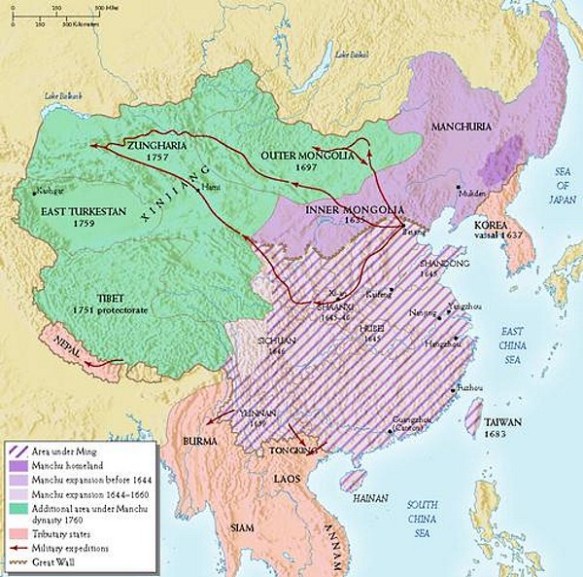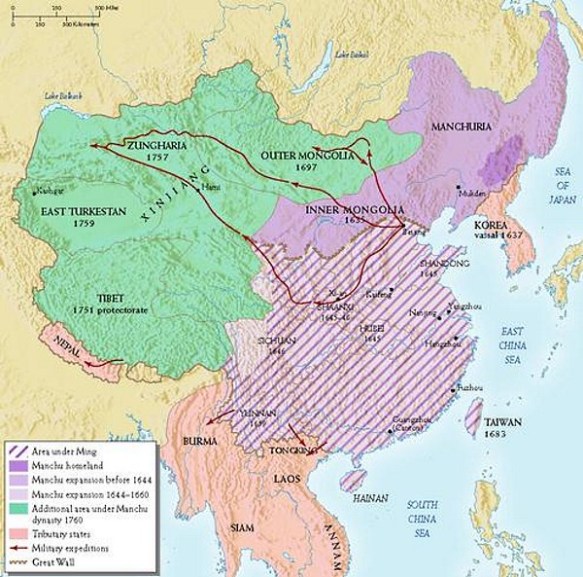
The Ming and Qing dynasties (before the Opium War) witnessed unprecedented consolidation and development of China as a unified multi-ethnic country.
In the early 16th century, the western colonial forces rapidly expanded into the eastern world following Portugal and Spain’s successful opening of the navigation routes. In 1548, troops of the Ming Dynasty heavily defeated the invading Portuguese fleet in Shuangyu near Ningbo, Zhejiang, burning seventy-seven battleships of different sizes. After that incident, the Portuguese employed means of deceit and bribery, saying their commercial ships had suffered windstorm, and were thus permitted to set up sheds in Macao to rest and dry their clothes. They went on to build ramparts, barbettes, and official mansions on the pretext of defending the invasion of the Dutch. In 1621, the Ming government destroyed the Qingzhou city built by the Portuguese, and levied an annual tax of 20,000 taels of silver upon the Portuguese in Macao. That paved the way for Macao’s later development into a colonial site, though the Ming Dynasty still had sovereignty over Macao.
In the middle Ming Dynasty, Japanese warriors, merchants, and pirates oft en harassed the southeastern coastal areas. They even once attacked Shanghai and Suzhou and finally reached Nanjing. In 1555, Qi Jiguang was entrusted to resist the Japanese pirates in eastern Zhejiang. He won nine battles in Taizhou and drove the Japanese pirates away in 1565.
In 1598, the Spanish attacked Guangdong, building houses at Hutiaomen. But their houses were later burnt down by the Ming troops, and the Spanish were chased out of Chinese territory.
In 1642, Dutch colonists invaded and occupied Taiwan, where they cruelly exploited the Taiwanese and their resources. In 1661, Zheng Chenggong, who had initiated wars against the Qing Dynasty in southeastern coastal areas, led a troop of 25,000 soldiers and hundreds of battleships to cross the straits eastward from Jinmen, successfully capturing Chiqian City, the strategic site of the Dutch troops. After another eight months of siege, he launched a fierce attack and finally forced Frederick Coyett, the Dutch Governor, to sign a document of surrender. Zheng’s successful reoccupation of Taiwan checked the further eastward expansion of the western colonists, ensured the stability of China’s southeastern provinces, and played an indirect role in protecting other Asian countries.
In the 1640s, Russian troops launched large-scale invasions into the mainland of China, occupying such northeastern areas as Yakesa and Nerchinsk. They brazenly plundered the areas, severely infringing upon the sovereignty of the Qing Dynasty and endangering both life and property. Qing troops waged two counterattacks in Yakesa in 1685 and 1686, defeating the Russian troops, who were forced to agree to a peace talk with only dozens of remaining soldiers. In 1689, both parties signed the Treaty of Nerchinsk, finalizing Qing sovereignty over the drainage areas of the Heilong and Wusuli rivers, including Kuyedao (Sakhalin Island). The treaty also provided that traveling businessmen of both countries could cross the borders for trade by presenting their passports. After the signing of the Treaty of Nerchinsk, the eastern part of the border areas between China and Russia enjoyed a relatively peaceful and stable situation that greatly facilitated bilateral trade.
The period from the Ming Dynasty to the early Qing saw effective counterattacks for safeguarding sovereignty, as well as zigzag but generally upward development in border areas where ethnic groups lived.
In the early Ming Dynasty, the remaining forces of the Yuan Dynasty that retreated to the Mongolian Plateau launched constant military attacks against the southern areas. In the middle of the Ming Dynasty, Wala unified all the Mongolian tribes, defeating a 500,000-soldier troop of the Ming Dynasty at Tumubao. He captured Emperor Yingzong alive and threatened the capital city of Beijing. In the early Jiajing Period of the Ming Dynasty, the Andahan Tribe of Tatar grew particularly strong. Between the Longqing and Wanli periods, Grand Secretary Zhang Juzheng initiated new reforms in the bordering areas with a view to “increasing the exchanges between the Han and Mongolians externally and reinforcing defensive systems internally.” Vigorous efforts were made to amend and cement the Great Wall and consolidate northern border defenses. As a result, Andahan couldn’t get through the northern border. His people urgently needed to exchange their goods for the farm produce of the central plains, so he begged for peace talks. The court of the Ming Dynasty accepted his request, conferring the title of King of Shunyi upon Andahan, and agreed to open eleven markets for exchange. From then on, the northern border areas saw a growing population, an increase in reclaimed land, and frequent commodity exchange.
Certain key border towns developed into “pearls at the frontiers” that differed little from the central plains. The Mongolian areas boasted not only a booming stockbreeding sector, but also a fast-developing agriculture, a vast area of reclaimed land, numerous villages, and the rise of Guihua City (present- day Hohhot). The Mongolians and Han people gradually merged with one another in many ways, such as ideology, culture, and folk customs. According to historical records, the Han people “living in bordering areas somewhat looked like the foreign people,” and were called “Han aliens” (Han Yi) during the Wanli Period. The Mongolian leaders also practiced the customs of Han, and even “prayed to be a member of Han in the afterlife.”
After coming into power in the middle 17th century, Galdan, from Mongolia’s Junggar Tribe in the West Desert, constantly launched attacks on its neighboring tribes. He later occupied areas both north and south of the Tianshan mountain range and colluded with the Russians to wage a large-scale rebellion. In 1690, Galdan attacked Inner Mongolia, also threatening to attack Beijing. To maintain national integrity, Emperor Kangxi of the Qing Dynasty personally led his army in war and defeated the rebel forces in Uklark Poktu. Qing troops carried out wars against Galdan and his successors for another seventy years. They eventually destroyed the aristocratic forces of Junggar in 1571 and unified the areas north of the Tianshan mountain range.
